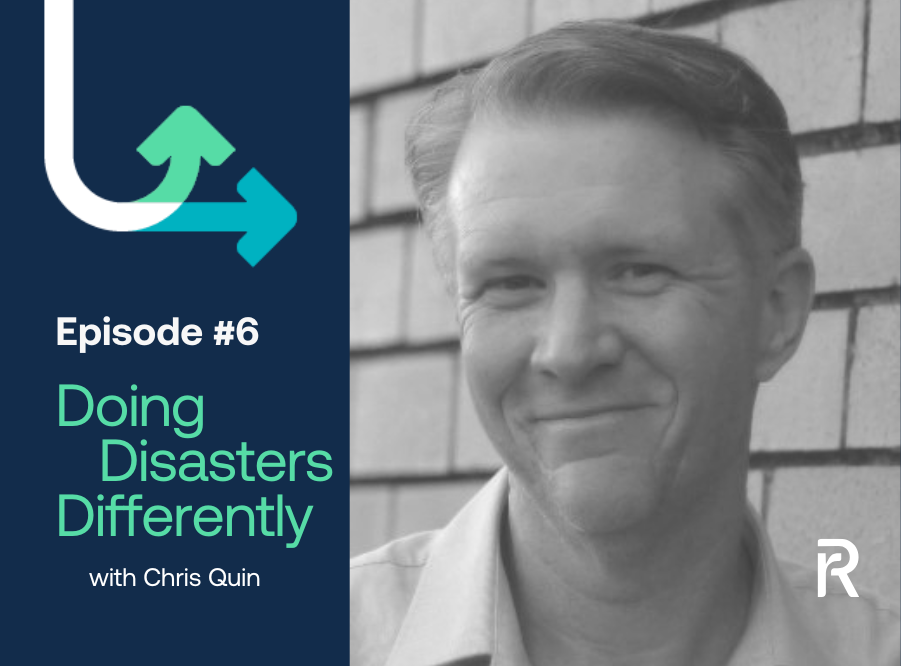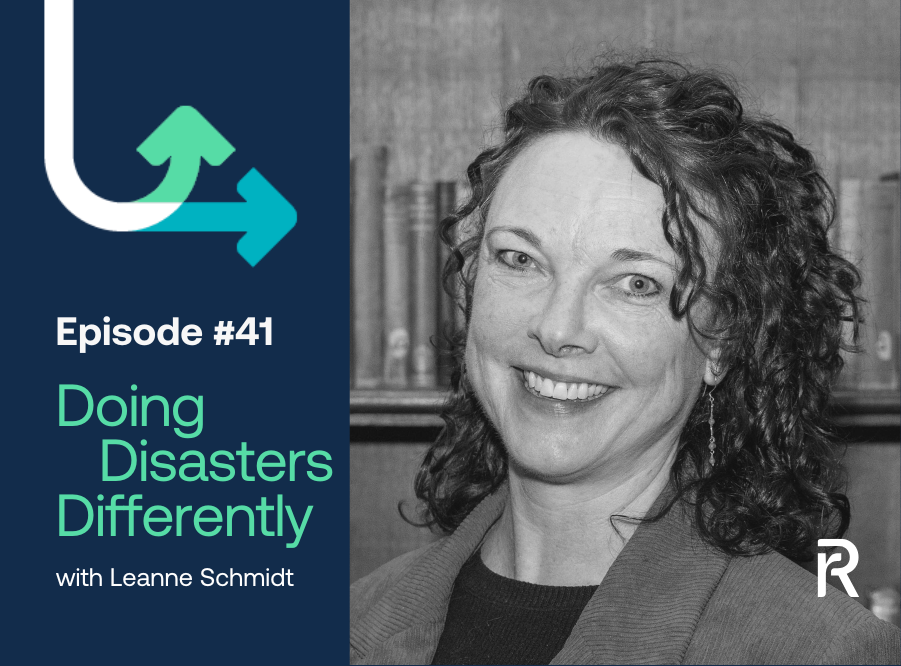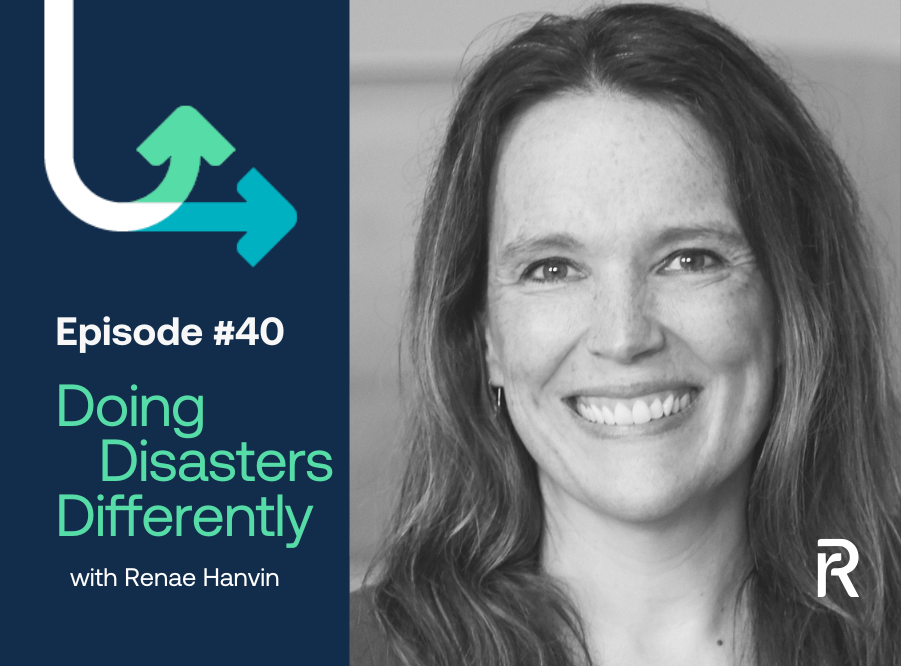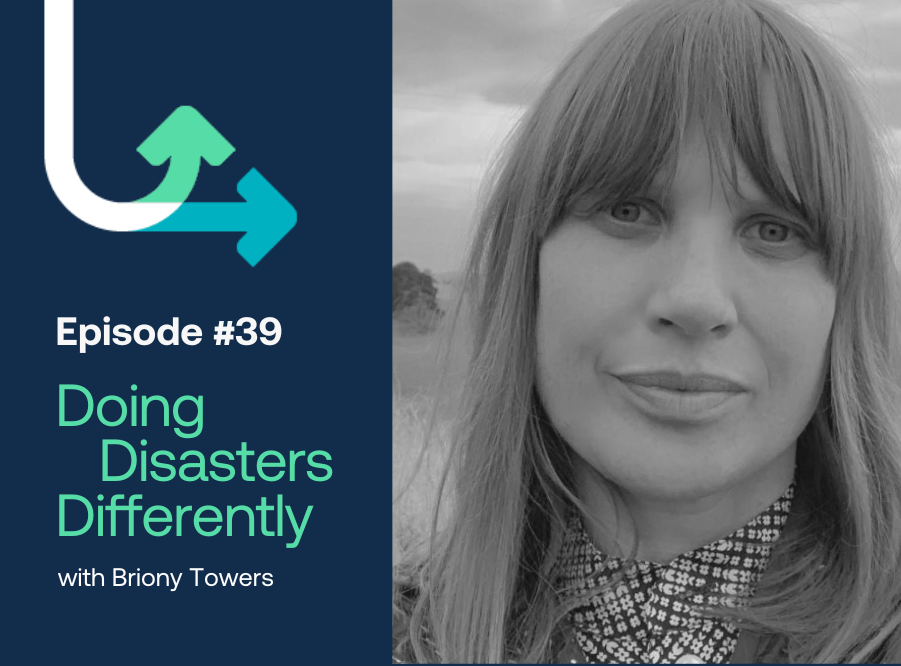
This episode
In this episode, Renae is talking with Chris Quin, who’s the Director of Resilient Projects. They discuss the new era of infrastructure resilience.
“I’m going to confess I didn’t know much about infrastructure resilience before I was connected with Chris at the 2019 Australian Institute for Disaster Resilience conference in Melbourne where we were both speaking. But since we met I’ve come to understand and appreciate the importance of infrastructure resilience in the holistic resilience conversation.”
This episode has great information and even greater examples including how resilient your cup of coffee needs to be – join Renae and Chris to see how he does disasters differently.
key moments from the conversation
Chris Quin is the Director of Resilient Projects.
Chris holds a Master’s degree in Disaster Preparedness and Reconstruction and is a Certified Practicing Project Director.
Chris has a keen interest in resilient infrastructure, and disaster preparedness and mitigation projects and has extensive experience in providing successful resilience solutions to state government, local government, large utilities, and emergency services organisations.
Chris has also worked in the response, recovery, and reconstruction effort to major natural disasters such as Cyclones Debbie, Marcia, and Yasi, and more recently in the Townsville Floods and is an active member of the Queensland State Emergency Service.
Chris is based in Townsville and we were introduced at the Australian Institute for Disaster Resilience and AFAC conference in Melbourne in August 2019. I think Amanda Lamont connected us.
It’s been a blossoming alignment ever since with some robust conversations relating to infrastructure, organisational and community resilience. What I like most is we get where each other is coming from and respect the value we each bring into the mix.
1. So I want to start with and this is a question that I kind of pretended I knew the answer to which I blatantly didn’t when I first got introduced to you at the conference. So what is infrastructure? resilience?
It’s a great question. It’s a complex question. But we’ll, we’ll sort of bring it back to some pretty key elements, infrastructure itself and the systems that we rely on every day without even knowing it. These are our transport systems, electricity, water, all of those things that we can’t do without but we really don’t appreciate them until we don’t have. Infrastructure resilience is really making sure our infrastructure networks and systems and the assets that comprise them are up to the task of providing that infrastructure under a wide range of circumstances. And it becomes really important, especially when we’re confronted with a crisis or natural hazard or technological hazard, that the systems are built really well.
2. So can you tell me who does infrastructure resilience relate to then – and I’m assuming it’s kind of everyone because we all rely on infrastructure service?
You are 100% right. Infrastructure relates to all this whether we know it or not. So you walk into a public building, you’re in a piece of infrastructure and how well that’s built, and how well it’s made impacts directly on how safe you are in that building, how usable that building is, and how you’re able to, to keep that building operating when circumstances get a bit different.
Infrastructure works really well 99.9 of the time, so well, we don’t even know it’s there. But when it doesn’t work well we certainly know about the lack of it. The coffee example is a good one because it’s very reliable. So the example I like to give of the complexity of providing infrastructure to every one to two people in the street people wherever they are, is when you walk into a coffee shop and ask for your cup of coffee. I tend to have a bit of a gratitude exercise I guess where I think about how that coffee has come to me. And most people think the barista which makes perfect sense that’s common good manners, but they don’t really think beyond the barista to where always come from.
So to get that cup of coffee from your barista in your local coffee shop, there’s four really complex and complicated supply chains to make that happen, but one of them is the coffee beans, the coffee beans almost always start overseas, they’re grown on a farm in another country. They need to be transported to a port. They’re shipped overseas to another port and then they’re transported to a processing center where they dried and ground usually in the country of destiny, the destination country like Australia. And then of course, there’s another transport layer where they get shipped to the coffee shop.
You think then about the electricity. It’s generated at an electricity plant. And then it’s transmitted through large transmission lines. It goes into a substation where it’s stepped down into distribution lines and then from distribution lines into the reticulation which gives you the following volts, it comes out of the water. And then the water. The water is stored in a bulk facility like a dam, or is it some sort of reservoir, it’s again, transmitted through a transmission pipe, it’s treated in a water treatment plan to make sure that it’s safe to use. And then it’s distributed, again through a smaller network to get to the place where you use distribution and potentially reticulation. And then you get the water at your location.
So, you’ve got the beans, you’ve got the electricity, and you’ve got the water that you need to make a cup of coffee, but you need the person as well. And generally, they have to get to work somehow. So there’s a whole transport network that they use to get to work and that could involve all sorts of things like trains or cars on roads require fuel fuel needs electricity pump. And, however they got to work there’s a whole bunch of subsystems that allow them to get work. So transport networks can’t run without electricity and it can’t run without communications. That’s how our traffic signals work and train signaling and those sorts of things.
So, you can see that as we build up this picture of the infrastructure required for a simple $5 cup of coffee, hopefully it’s not costing you too much more than that. It there’s, there’s a lot that goes into making that happen, and many, many really complex and technical systems that allow that transaction to occur.
3. So infrastructure resilience, I guess, underpins our system and way of living? I’m talking to Dr. Margaret Morton in a future episode about community resilience, obviously, being the people and how people interconnect. But I guess the people and the infrastructure is kind of really interwoven, because we can’t live or certainly not to the level of how we’d like to live at the moment if we don’t have those systems and structures working for us to deliver the likes of the coffee beans and the water and the electricity and the ability to get to work.
You’re absolutely right. And I I’ve had my own personal experiences of hazard events that have turned into disasters, especially living in North Queensland, we get hit with fairly significant cyclones. And I firsthand, I’ve seen what happens to the community when the infrastructure is kind of yanked out from underneath them. And when infrastructure fails it can fail safe or unsafe. What we want is infrastructure to fail safely so that it doesn’t harm. But I have seen infrastructure fail in ways that weren’t safe and actually increased the risk to the community. So it’s really important that not only do we provide a good service, we provide safe service in the world of infrastructure.
4. Do you think infrastructure resilience is kind of like the forgotten cousin or the third child or do you think it needs a bit more airtime?
Absolutely. I believe it’s one of those elements that we if we have a greater awareness of it and the importance of it, many, many people would have hopped on a train in a major capital city in Australia. And seeing the sign, you know, if there’s a problem with this infrastructure, please report it, here’s a phone number or whatever, and kind of ignored that, you know, not being particularly worried about that. But I think if we all appreciated the the sort of long supply chains that are created with our infrastructure, I think we would possibly do a better job of supporting our infrastructure to remain.
We’re just so used to being available to us. But as I’ve said, I’ve seen in many events, where it’s not available, and that creates a lot of stress and strain on the community. And it’s a time when they need their infrastructure. So you can imagine how much more difficult it is to recover from a really large hazard event when you don’t have electricity or worse, you don’t have clean water. So you know, these sorts of things are really, really important to understand. And look, I think, in Australia, especially our infrastructure operators do an excellent job and in some ways, that’s why we don’t know much about this is because they do such a good job that we’re sorry. Just so used to having the infrastructure available to us and the service that it provides, more importantly, that we don’t even think about it. And to some extent, that’s a really, it’s a real acknowledgement of how well we do do this in this country.
However, it’s important that we all play our part and that we kind of dedicate a little bit of time and effort into this. Because when the bridge is out, and you can’t cross the river to get to the hospital, and both really significant pieces of infrastructure, that’s when things start to get a bit problematic. And we will be better thinking about that effectively before the storm before the hazard if we do some work, getting our infrastructure ready, preparing our infrastructure, making sure it’s available during that variety of circumstances before the storm, we’re going to do so much better than trying to fix it in recovery. And, you know, I think that’s been really acknowledged by people who are invested in infrastructure resilience over the past decade or so probably longer, but we started out with this idea of fun You know, the fact that assets needed to be hardened. And this has been a concept in engineering for many, many years, I call it robustness. We now call it resistance to hazards, but very, very similar concept where, you know, you build the asset strong enough, and it won’t get knocked over.
5. Can you explain where does infrastructure resilience fit alongside community and organisational resilience?
Yeah, absolutely. I think, look, I think community resilience should be the ultimate goal. What there wouldn’t be any infrastructure if there wasn’t a community. So you know, there’s no electricity supplied to the middle of the desert because there’s no need for electricity to be supplied to the desert. So wherever there’s a large population of people that’s where the infrastructure gets picked up, you feel like the systems are, there are many more systems and the systems are usually stronger, we would certainly hope that they were stronger where there are large concentrations of people. So community resilience is key.
But I think both infrastructure resilience and organisational resilience have a key role in underpinning communities and, when there’s been large events, either in Australia or overseas, I’m thinking of Hurricane Katrina in the United States. When, you know, a terrible event comes along that does damage to major pieces of infrastructure that benefits the community. I know for a fact that in a company that was looking after the energy grid during Hurricane Katrina, people whose houses and effectively washed away were sleeping on the floor in the office, in an attempt to make sure that they could continue providing electricity to the rest of the people that needed to be in that area to maintain their recovery.
So those organisations are responsible for sort of mobilising those people that belong to the organisation, because we draw those from the community. And without the community, you can’t staff the organisation, which means the infrastructure suffers, it can’t be run as well. Because there’s always going to be a need for people to support that infrastructure, restore that infrastructure, and allow that infrastructure to get to that sort of holy grail of being able to anticipate and transformed in the face of these really large events.
And the other thing I’d add to that is we know that events are more frequent. And we know that they they cost more, they damage, more infrastructure. That’s not just a function of the events. It’s a function of how we build cities and communities. We build them sometimes it has been in situations or we go them in a more aggregated way with larger urban density. So we know that there’s more risk. So we kind of there is a natural risk that comes from more frequent natural hazards, but there’s a created risk as well. So the natural risk we actually add to the risk by creating some vulnerabilities. It’s really important that we understand the importance of infrastructure resilience when we’re right back at the planning stage, when we’re planning utilities, when we’re planning for new infrastructure, we work on them because it’s much easier and cheaper to fix it right back at the start than it is to try and sort and adapt our infrastructure once it’s in place.
6. Can I ask you, what’s great about infrastructure resilient in Australia right now?
I think there’ll be several projects, many projects across, especially the last 20 years, and I’ve been fortunate enough to be involved in some of those, recognising that infrastructure is key. And in fact, in some ways, the current major crisis of the world faces recognises the benefits of infrastructure. So we know that there’s a thing called the interest rate gap. So there’s the infrastructure we need and the infrastructure that we have. And the difference is the infrastructure gap.
Trying to create an economic recovery from the COVID-19 crisis in most countries, certainly most countries that can afford to and are using infrastructure as a means to kind of build ourselves out of out of the hole in the economy. And I think that’s really helpful. We know that that can work that can provide both economic stimulus, but also amenity to the community. So we know that that works.
And what I would say though, is we need to get the message about infrastructure resilience out into the world, wider community, so that when we fill that infrastructure gap, when we build the new infrastructure, I know we’re going to build over the next 20 years and in fact, in the next 20 years, we will build worldwide, more infrastructure than we have in the rest of human history combined. So we know that we’re going to be filling that infrastructure gap because it’s so large. And we know we need this infrastructure.
But what’s important is that we build it to last. We don’t just build it to meet the needs of right now, we build it to meet the needs of the useful life of that infrastructure. If you look at a piece of infrastructure, like the Sydney Harbour Bridge, which has been a very successful piece of infrastructure, but it’s been in place for over 120 years. So if we just build the infrastructure to meet the needs of today, we really are losing an opportunity because much of the infrastructure that we built 100 years ago, we’re still using today.
And we know that the world is going to be a very different place 100 years with climate change, and the changes in the frequency of natural hazards and even the human made threats. We know that the world is going to be a different place. So we should be using our imagination to imagine the the absolute set of hazards and disruptions that could occur to our infrastructure and building some resilience and right back at the stage and now is the time to do. If we spend just a little bit more at the outset, if we make sure that the infrastructure is both resilient and sustainable, the world is actually going to be a better place as a result.
With my final question always…
1. I might pick one that I think is effectively low hanging fruit, one that we can do with just a little bit of effort in time, maybe a little bit of effort in money. But I’d love to see better partnerships, I’d love to see better collaboration. So as you mentioned, many people don’t understand, don’t quite understand the importance of infrastructure, especially when it comes to disaster response or when there’s a hazard that affects the community and how important it is.
We know the electricity network really heavily interacts with the communications network. And we know that they both heavily really interact with water network. And then we know that all of those interact with the transport network. And then we know that they interact with the hospital, which is absolutely critical when we when we talk about any type of hazard. So I would love to see better communication between those different elements of infrastructure and the organisations that look after them, so that we can do a better job of making sure that the hospital stays and that people have fresh water.
So communication partnerships that can that can be sort of outworked as far as multi agency exercises and those sorts of things are concerned. So I’d love to see better partnerships between the providers in a single infrastructure space, better partnerships between providers across infrastructure, but then better partnerships between infrastructure organizations, and emergency management organizations. So depending upon what jurisdiction you’re from, emergency management may be centered on local government or state government, federal government.
And I’d love to see those partnerships really, really strong. I call them and I borrowed this from from a colleague 3am friends, the people who will take the phone call at 3am. That network of 3am friends needs to be pretty wide and pretty strong. So that when things do go wrong at 3am in the morning that someone will take your call and then you can affect them. Late, hopefully reduce the impacts and the consequences of any hazard event and get on to, you know, get, you know, restoring services and making sure everybody’s safe as soon as you possibly can.
2. Number two for me would be a longer term view. So instead of just building our infrastructure to current standards or codes, I love to see is taking that longer view and when when infrastructure is in a more hazardous place, go beyond the codes go beyond the standards actually build it to last so and the UN had a great week last sorry, the International Day for disaster risk reduction in 2019 was focused on infrastructure is to raise that visibility to and the hashtag was hashtag build to last. That is vital. You need to build these things to last we can’t just build them to the standard in hazard prone locations.
We need to think more about what we’re doing. So creating those systems that will serve us not just during the best of times.
Connect with Chris Quin



